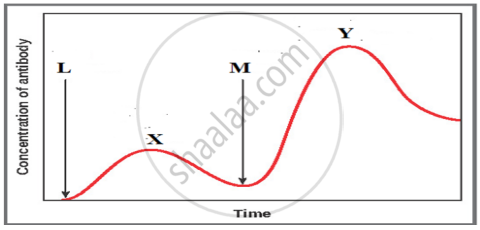Advertisements
Advertisements
प्रश्न
The graph given below indicates the administration of the first (L) and second dose (M) of a vaccine. The corresponding response of the body is indicated by X, and Y. Interpret the graph and explain the reason for such a response shown by the body.

उत्तर
- On administration of the first dose of the vaccine (L), the body shows a response of low intensity (X) as the immune system comes in contact with the antigenic protein of the weakened/inactivated pathogen for the first time. This is called primary immune response.
- On subsequent encounters with the same antigenic protein in the second dose (M), the body elicits a highly intensified secondary response (Y). Because of the memory of the first contact with the antigen, the secondary immune response is faster and stronger, leading to more effective pathogen elimination in comparison to the primary immune response.
APPEARS IN
संबंधित प्रश्न
Explain how insulin can be produced using recombinant DNA technology.
Answer the following question.
Describe the roles of heat, primers, and the bacterium Thermus aquaticus in the process of PCR.
Describe the role of bacterium Thermus aquaticus in carrying the process of polymerase chain reaction.
If a person thinks he is infected with HIV, due to unprotected sex, and goes for a blood test. Do you think a test such as ELISA will help? If so why? If not, why?
A pathophysiology is the ______.
What is a recombinant DNA vaccine? Give two examples.
A patient is suffering from ADA deficiency. Can he be cured? How?
Name the five key tools for accomplishing the tasks of recombinant DNA technology. Also mention the functions of each tool.
How does a gene therapy involving direct modification of the cells, in order to achieve a therapeutic goal is used in the treatment of ADA deficiency? Explain.
Explain how recombinant human insulin was prepared in 1983 by Eli Lily an American company.
